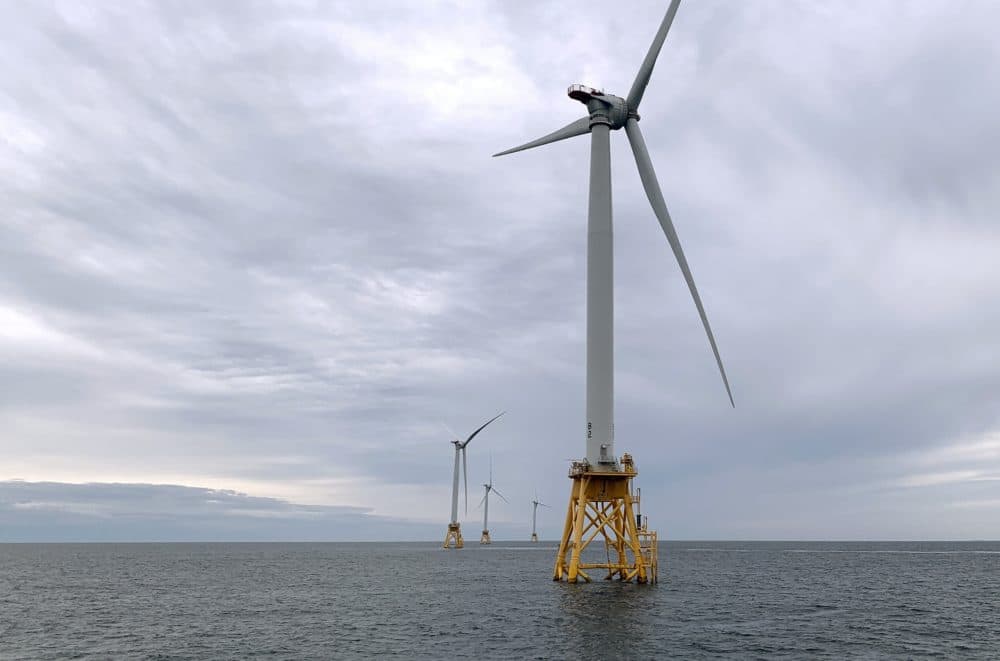Advertisement
New England Offshore Energy Companies Recommend Turbine Grid

All five companies that hold leases for offshore wind sites off New England have proposed that they adopt a uniform layout of turbines that would create hundreds of predictable navigation corridors for fishermen and other mariners by installing all of their turbines in fixed east-to-west rows and north-to-south columns spaced one nautical mile apart.
The proposed layout would create a grid across the seven lease areas, mirroring an arrangement that the companies said is "preferred by many stakeholders, including fishermen operating in the region," and could potentially address one of the concerns thought to have led to the federal government effectively freezing the Vineyard Wind 1 project until it can learn more about the new industry as a whole.
Having a consistent turbine layout across the seven adjacent lease areas, the companies said, would provide fishermen with the benefit of not having to change their practices as they pass from one lease area to another, and would promote safe maritime navigation.
The companies said their proposed "1x1" arrangement would create "231 transit corridors in four cardinal directions" and asked the U.S. Coast Guard to support adoption of the proposed layout "with no additional designated transit corridors."
"The existence of numerous corridors, in multiple directions, consistently across all lease areas, would be preferable to having a restricted number of designated transit lanes," the companies wrote in a Nov. 1 letter to the Coast Guard's director of Marine Transportation Systems. "Because most of the vessel traffic in the [New England Wind Energy Area] are fishing vessels ... and fishing vessels utilize a wide variety of transit paths, having the ability to safely transit in any of four cardinal directions from any point within the NE WEA best accommodates the largest number of vessels operating in the area."
The five companies asked that the Coast Guard incorporate their proposal and a corresponding report conducted by maritime safety consultant W.F. Baird & Associates Ltd. into the ongoing Massachusetts and Rhode Island Port Access Route Study.
Ahead of the public release of the letter from the offshore wind developers, a communications firm that represents fishing, shipping and other ocean-related clients sent word Monday evening that the announcement may be coming and that the fishing community is not as pleased with the announcement as the developers might suggest.
"Many fishing industry leaders have concerns about such an announcement coming before the US Coast Guard releases its currently underway study on the potential safety effects of turbine spacing," Robert Vanasse of Stove Boat Communications, who also serves as executive director of the pro-fishing industry advocacy group Saving Seafood, wrote in an email to reporters.
Tensions between the commercial fishing industry and offshore wind developers have been a constant thread as the new industry looks to establish its roots in the United States. The announcement of a proposed uniform layout of turbines comes while Vineyard Wind 1 — a $2.8 billion project to operate the country's first utility-scale wind farm off the American coast — awaits the results of a supplemental review of the wider impacts of the burgeoning offshore wind industry that the federal Bureau of Ocean Energy Management began in August.
The Trump administration injected a level of uncertainty into the project when the Department of the Interior and BOEM notified project officials that the government was "not yet prepared" to issue a final environmental impact statement, which had been expected in August. Federal officials say they are now operating within a review window that extends to March 2020.
Reuters reported that the National Marine Fisheries Service "triggered the delays by declining to sign off on the project's design, as proposed by the Bureau of Ocean Energy Management" and that a regional director for the agency "said his agency could not support the environmental permit for Vineyard Wind because the project failed to fully address the concerns of the fishing industry."
The configuration of the project's turbines has been a point of contention as Vineyard Wind has sought to shore up consent from the fishing industry. Fishing interests have taken issue with how Vineyard Wind planned to orient its turbines from northwest to southeast rather than from east to west, and with the amount of space (average of 0.88 nm) between turbines.
A Vineyard Wind official told the News Service that BOEM's draft environmental impact statement already identified and analyzed the possibility of using the 1x1 layout, and that no additional review or analysis would be needed if the project is directed to adopt the 1x1 layout. The company is willing and able to adjust its plan to accommodate the 1x1 layout.
When Vineyard Wind vowed in August that its project would move forward despite the federal government's delay, the initial version of its press release had CEO Lars Pedersen saying that Vineyard Wind would meet its targets but "in a different configuration." That line was inadvertently included in the quote, a Vineyard Wind official said at the time, adding that there had been no discussion of changing the configuration of the wind farm's turbines at that point.